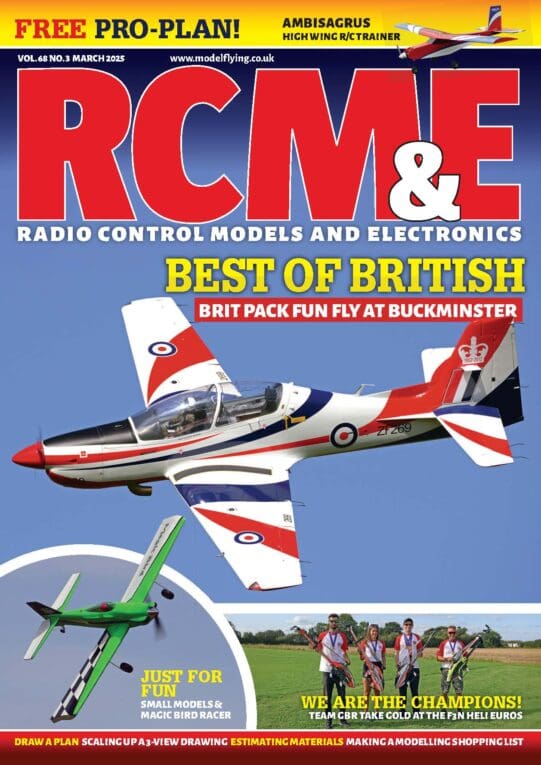YOU WILL NEED:
1. Balsa for longerons and uprights (6 x 6mm pictured).
2. Balsa for gussets (in this instance, 6mm sheet to match the longeron thickness).
Enjoy more RCM&E Magazine reading every month.
Click here to subscribe & save.
3. Balsa for diagonals (6 x 3mm or as directed by your plan).
4. A small saw.
5. A scalpel.
6. Modelling pins.
7. PVA or aliphatic wood glue.
8. A flat building surface, a plan and a transparent glue resistant cover.
1. Whether building from a plan or commercial kit the standard built-up box section fuselage will normally be constructed from stock wood over a traditional plan, employing the joints and materials shown in the sequence that follows.

2. I use two methods for securing this type of work to the plan. Either: a.) pins pushed through the wood or, b.) two pins to clamp the wood in place. Thin pins pushed through the wood are less likely to split the work. Thicker pins, on the other hand, can be used to clamp thinner sections balsa or spruce.

3. Lay the plan out onto a flat building board and cover it with a transparent plastic sheet in order to stop the work sticking to and spoiling the drawing. Begin by pinning down the top and bottom longerons. For clarity, the transparent sheet has been omitted in these pictures.

4. Sand or cut one end of the upright to the correct angle. In this instance I’ve chosen the upper joint as it’s a simple 90 degree cut. Place this end lightly against the top longeron and mark the cut at the bottom end, from underneath, with a scalpel.

5. Using a fine bladed hobby saw, cut along the marks created by the scalpel blade. Remember to keep the blade upright and don’t rush the job by pushing down too hard on it; let the saw do the cutting.

6. I tend to cut the uprights just to the outside of the scalpel marks, so that they’re a fraction long, then lightly sand the end until they’re an accurate fit. When sanding the uprights or braces be careful to keep the work square so as not to round the end.

7. It’s good practice to pre-glue the end grain of the wood when making this type of joint. To achieve this, simply wipe a small dab of glue on the end of the uprights and let it soak into the fibres of the balsa, but don’t let it cure completely. Incidentally, this practice does not apply when using cyano.

8. Apply glue to both ends of the upright and push it into position making sure that you’re not forcing the longerons apart, thereby weakening the other upright joints in the structure. Using a piece of scrap wood, clear away any excess glue before it cures.

9. The triangular corner braces (gussets) must be cut so that the grain is not in line with either the longeron or upright. Some kits include laser cut gussets and it’s always worth checking the grain before fitting. Cut, sand and pre-glue the gussets as you did the uprights.

10. Given that you’ll have to make two cuts at each end, the diagonal braces can be a little trickier. Fashion one end first, make and cut the other (again possibly slightly over size) and then sand to fit. As these components are thinner than the rest of the structure it may be prudent to clamp the work in place with pins.

11. Leave your work to cure properly. Some PVA and aliphatic glues suggest quick drying times, however my preference is to leave the structure overnight. Hold down the assembly to avoid it lifting and getting damaged as you remove the pins.

12. Glue can make the balsa around the jointed areas harder than the rest of the structure. As such, one common mistake is to use too small a sanding block, which can result in an uneven, wavy finish. Use a large sanding block that bridges many joints in one go.
WORTHY OF NOTE:
The backing plastic from a roll of Solarfilm or Solartex is perfect for covering plans. So far I’ve failed to find a glue that will stick to it. If unsure, try a test piece to see what happens… My preferred glue for this type of joint is white PVA wood glue, although aliphatic white glues have an advantage in that they sand much better… If building from a kit, remember that you’ll only get just enough wood for the build. To save a little personal frustration, then, it may be worth purchasing some extra, to accommodate mistakes and enable practice attempts to be made.




